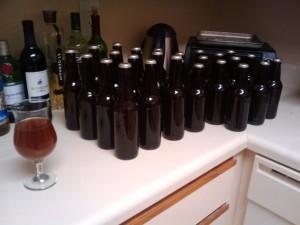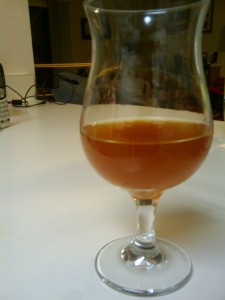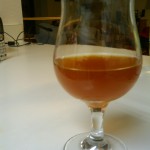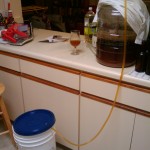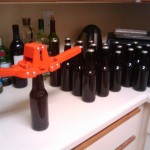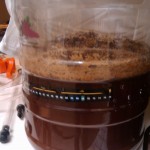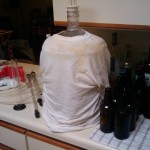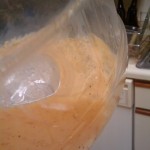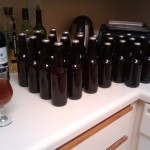Beer update: Special bitter is bottled!
I am always surprised when I rack the correct amount of beer into the bottling bucket, even though I use brewing software that accounts for liquid losses when transferring from the brew kettle to the fermenter. When bottling last night, I had the presence of mind to take some pictures, so I’ll share with you the process as I describe the beer.
This brew has been pretty much all upsides and no downsides. Before pitching with Windsor, I read up on it some more and saw that it was not very attenuative. (Which just means it will ferment less of the sugar in the long run. It’s not greedy.) Fortunately, I thought to add some corn sugar–a very easy-to-metabolize sugar–to the fermentables. So the yeast did its job and then some. All in all I was expecting a 4% ABV beer, but with the slightly higher Original Gravity and the slightly lower Final Gravity, I got a beer that is 4.3% ABV ![]() Best of all, the Sidhe’s comment on tasting it was that I should enter this into a homebrew competition!
Best of all, the Sidhe’s comment on tasting it was that I should enter this into a homebrew competition!
A couple of variables were in play, as I noted in my last update. First and foremost, the late addition of the malt extract and sugars is dramatically noticeable. The gravity sample gave zero “twang” when I drank it–not even a hint of weirdness. I shall adopt this technique from here on out, and I expect that future results will continue to confirm this initial observation. Neither does it taste especially more bitter. (But it shouldn’t, because I adjusted the hopping back to the target IBU.) On the other hand, the change in my hop schedule is definite. I had initially brewed this with Fuggles and Kent Goldings together, but when I changed the hopping, I moved the Fuggles up to aromatics and kept the Kent Goldings in the flavor zone. (Take a look at this chart if you’re confused.) Well, the spiciness that characterized the first batch is gone, and the flavor is dominated by the smooth, even Kent Goldings. It’s incredibly quaffable, but I think the Fuggles added a certain flavor that suits this beer better. In future iterations I shall walk the Fuggles back in (maybe 5 minutes at a time, until I hit 20 minutes) to get a clear understanding of its flavor properties.
The extra time in the fermenter seemed to help with clarity. But, as you can see, it’s still quite hazy. I finally acquired some Irish moss, so I’m not going to mess around without it anymore.
One final major factor that I think affected the quality of this beer was the temperature control. During fermentation, yeast generate quite a bit of heat, and this can change the flavor profile of the yeast’s by-products. I was extremely attentive to the process this time, starting at a good pitching temperature (64℉) and keeping it as close to that as I could. I checked on it every few hours for the first day, re-wetting the tshirt that girdled the fermenter and keeping the fan blowing. I have detailed temperature/outgassing rates in my brewing log that I won’t bore you with, but during the main body of activity (when the airlock was bubbling 8 times every 10 seconds), I kept the fermenter under 66℉ the whole time, and only once did it dip below 64℉. This sort of temperature regulation, I have read, is vital to ensure that the yeast are kept in the same environment, and therefore are stressed less and produce more consistent results.
I keep meaning to save the yeast from my batches for reuse, but I never have the presence of mind to do so. I shall do that some time this year, I promise, and I hope to document it! Nor have I forgotten about my YouTube channel; I just don’t have a good computer from which to record video. I was going to use my netbook, but trials quickly showed me that it’s a piece of junk for actual work tasks.
I have 11 more beers to brew in 2012! (I’m counting this one, because it was brewed after I made my New Year’s Resolution to do so.) I have a few ideas about what I’m going to do next, but I open the field to you for suggestions. What styles of beer should I brew? Any special ingredients? Tell me what you think! And while you’re thinking, enjoy the rest of these images of the bottling process.
- Siphoning the finished beer into the bottling bucket
- Capping the bottles, one at a time.
- So that’s what’s under a lady’s skirt!
- All my tools at hand.
- The yeast cake, whose fate is to be washed away :(
- 29 bottles of beer on the wall, 29 bottles of beer…

